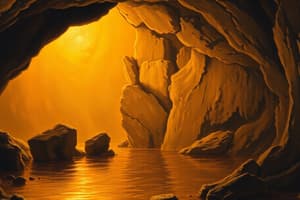Podcast
Questions and Answers
What was the main aim of Surrealists?
What was the main aim of Surrealists?
- To represent feminine experiences
- To express the unconscious mind and imagination (correct)
- To challenge gender roles and stereotypes
- To critique consumer society
During which period did the Renaissance art movement take place?
During which period did the Renaissance art movement take place?
- 12th to 13th century
- 14th to 17th century (correct)
- 6th to 9th century
- 18th to 19th century
Which art movement emerged as a response to the post-war consumer boom?
Which art movement emerged as a response to the post-war consumer boom?
- Feminist Art
- Pop Art (correct)
- Surrealism
- African Art
Which of the following is NOT a characteristic of Renaissance art?
Which of the following is NOT a characteristic of Renaissance art?
What inspired Pop Art artists like Andy Warhol and Roy Lichtenstein?
What inspired Pop Art artists like Andy Warhol and Roy Lichtenstein?
What distinguishes Surrealism from the Renaissance art movement?
What distinguishes Surrealism from the Renaissance art movement?
What is a common characteristic of many traditional African artworks mentioned in the text?
What is a common characteristic of many traditional African artworks mentioned in the text?
Which ancient civilization's art is included in the term 'ancient art'?
Which ancient civilization's art is included in the term 'ancient art'?
How have art movements like Impressionism and Expressionism evolved over time according to the text?
How have art movements like Impressionism and Expressionism evolved over time according to the text?
What defines an art movement in the context of art history?
What defines an art movement in the context of art history?
What role have art movements played based on the information provided in the text?
What role have art movements played based on the information provided in the text?
What was a key factor that led to the emergence of Surrealism in Europe?
What was a key factor that led to the emergence of Surrealism in Europe?
Flashcards are hidden until you start studying
Study Notes
Art Movements
Art movements are a significant aspect of art history, reflecting the evolution of artistic expression and the cultural context of their time. These movements are characterized by a shared goal, particular style, and common agenda, and they have played a crucial role in shaping the art world. In this article, we will explore various art movements and their key characteristics.
Ancient Art
The term "ancient art" refers to the artistic creations of different cultures before the fall of the Western Roman Empire in 476 AD. This period includes the art of ancient civilizations such as the Egyptians, Greeks, Romans, and the cultures of Asia, Africa, and the Americas before the rise of Greece. Ancient art is often categorized geographically, as each culture has its unique look and character.
Renaissance
The Renaissance was a period of cultural and artistic revival in Europe, which began in Florence, Italy, in the 14th century and lasted until the 17th century. It was characterized by a rediscovery of classical art and literature, leading to a new emphasis on humanism and individualism in art. Some key characteristics of Renaissance art include naturalism, contrapposto, chiaroscuro, sfumato, and linear perspective.
Surrealism
Surrealism emerged in Europe after World War I and lasted until the late 1920s and early 1930s. It was an artistic and literary movement that sought to express the unconscious mind, dreams, and imagination through fantastical and dreamlike imagery. Surrealists aimed to create super-reality or surreality, allowing the unconscious to manifest itself.
Pop Art
Pop Art emerged in the mid-1950s and was established in Britain and the United States. It was a response to the optimism during the post-war consumer boom and drew inspiration from popular cultures and new trends in art, such as comics, ads, and television. Pop Art artists like Andy Warhol and Roy Lichtenstein used bright colors and bold images to critique consumer society.
Feminist Art
The feminist art movement emerged in the 1960s to provide female representation in art and the world. Feminist artists aimed to represent feminine experiences, often through vaginal imagery and the naked female body. They sought to challenge gender roles and stereotypes in art and society.
African Art
African art is diverse and encompasses a wide range of objects, materials, media, and themes. It shares marked characteristics, such as the intended function as talismans or vessels for communicating with the dead. African art has had a significant impact on the development of modern art in Europe, with movements like Cubism being influenced by African carvers' abstract representations of reality.
Art Movements and Spirituality
Throughout history, art has been closely linked to spirituality, reflecting the close relationship between art and spirituality throughout human history. Many traditional African artworks were created for religious and ritual purposes, and they often had magical properties in the context of specific rites or events.
Art Movements and Modern Life
Art movements have also been influenced by modern life and its changes, with movements like Impressionism and Expressionism reflecting the emotional response to the subject matter. These movements have evolved over time, with contemporary art being characterized by a disregard for techniques and the context of creation.
In conclusion, art movements have played a significant role in shaping the art world and reflecting the cultural context of their time. From the ancient civilizations to modern movements, art movements have provided a framework for analyzing and appreciating art, showcasing the diversity and richness of human creative expression.
Studying That Suits You
Use AI to generate personalized quizzes and flashcards to suit your learning preferences.




